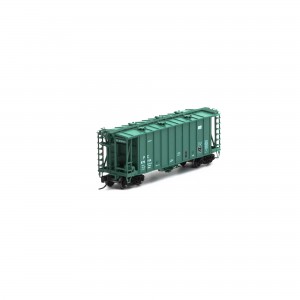Categories
- Advance Reservations
- Couplers, Trucks & Wheels
- Detailing Parts
- Freight Cars & Loads
- Locomotives
- Passenger Cars
- Signals and Lights
- Structures/Scenery & Accessories
- Track & Accessories
- Train Packs/Train Sets
- Vehicles & Figures
- DC/DCC Control
- Adhesives/Lubricants/Tools/Paints
- DVDs, Publications, Decals, Signs etc.
- Order Non Listed Item
- British/European/Japanese
- Kato Unitram & Trams
- HO/OO Scale
- Z Scale
MODEL FEATURES:
- Three road numbers
- Early GATC Airslide body: no angled end gusset plates; channel-section vertical posts at bolsters
- Detailed underbody including outlet piping
- Rectangular or oval shaker brackets
- Gravity or gravity-pneumatic outlets
- See through metal roof walk
- Factory installed wire grab irons and brake piping
- Separately applied round roof hatches and brake wheel
- Roller bearing or Bettendorf trucks
- Fully-assembled and ready-to-run out of the box
- Accurately painted and printed
- Highly detailed, injection molded body
- Machined metal wheels
- Weighted for trouble free operation
- Body mounted McHenry® operating scale knuckle couplers
- Clear plastic jewel box for convenient storage
- Operates on all popular brands of track
- Minimum radius: 9 ¾”
PROTOTYPE INFORMATION:
For the first half of the 20th century, bulk goods were usually bagged and carried in boxcars. After the late 1940s, covered hoppers greatly simplified the process by allowing the bulk material to be poured in through the roof hatches and dumped out the hopper bays. However, flour, starch, sugar and plastics do not “flow” easily from a standard hopper bay.
To solve this problem, the Fuller Company of Catasauqua, PA, patented the Airslide concept. In an Airslide covered hopper, the bays are formed into two narrow, steep-sided troughs with a layer of air-permeable material at the bottom. Air is pumped through the material causing the lading to fluidize and flow easily through the hopper outlets.
Starting in 1953, General American Transportation began building Airslide covered hoppers. One of the two original configurations was a 2,600-cubic foot, single-bay car with a 70-ton capacity. In addition to railroad-owned cars, there were a number of Airslide covered hoppers leased by GATC to sugar and bakery companies.
Specifications
| PROTOTYPE MANUFACTURER: | General American |
| COUPLER STYLE: | McHenry Scale Knuckle |
| ERA: | 1960s+ |






